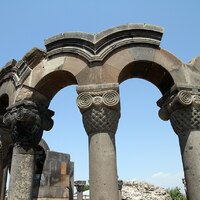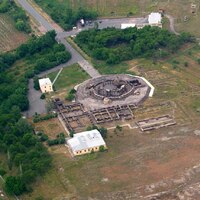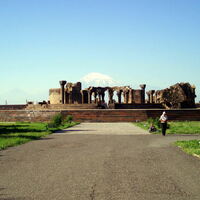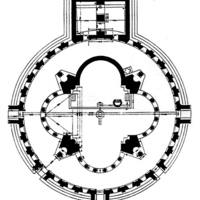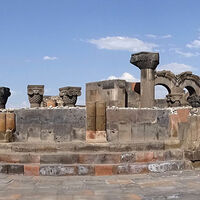Zvart'nots'
Date:
640 to 661
Location or Findspot (Modern-Day Country):
Armenia
Dimensions:
Urartian stele, 220 × 62 cm
Description:
The Armenian catholicos (patriarch) Nerses III (r. 640–61) built a large church dedicated to the Vigilant Powers (angels) at Zvart'nots'. Like the church at Mren, Zvart'nots' was erected at a time of tension between Byzantium and Armenia and between Armenia and the expanding Islamic realm. The site was connected to an event in the life of Armenia's first bishop, St. Gregory the Illuminator (d. 331), and it incorporated other references to the past as well, including spolia (a 2-meter-tall cuneiform stele of the seventh century BCE) and a view of Mount Ararat (Gen. 8:4), where the stone for Armenia's first churches was quarried. Zvart'nots' was abandoned after an earthquake in the tenth or eleventh century.
The round domed church was elevated on a stepped platform (like a built mountain). It was encircled by an ambulatory and screened from it by curving colonnades and a solid semicircular apse, forming an aisled tetraconch. This double-shell construction was enclosed in a 32-sided perimeter wall. The blind arcade of the exterior facade had extensive relief sculpture in the spandrels, both vegetal motifs and human figures that hold tools for planting and building. The four huge piers supporting the dome had attached columns topped by a sculpted eagle. The columns in the tetraconch had basket-shaped capitals bearing the cruciform monograms "of Nerses" and "of the catholicos" in Greek, perhaps announcing by their language choice the patron's allegiance to Byzantine Orthodoxy rather than the Armenian Miaphysite faith. In combining cross-shaped monograms and eagles, Nerses may have imitated imagery on contemporary Byzantine seals.
The round domed church was elevated on a stepped platform (like a built mountain). It was encircled by an ambulatory and screened from it by curving colonnades and a solid semicircular apse, forming an aisled tetraconch. This double-shell construction was enclosed in a 32-sided perimeter wall. The blind arcade of the exterior facade had extensive relief sculpture in the spandrels, both vegetal motifs and human figures that hold tools for planting and building. The four huge piers supporting the dome had attached columns topped by a sculpted eagle. The columns in the tetraconch had basket-shaped capitals bearing the cruciform monograms "of Nerses" and "of the catholicos" in Greek, perhaps announcing by their language choice the patron's allegiance to Byzantine Orthodoxy rather than the Armenian Miaphysite faith. In combining cross-shaped monograms and eagles, Nerses may have imitated imagery on contemporary Byzantine seals.
Relevant Textbook Chapter(s):
3
Image Credits:
Wikimedia Commons, Flickr

